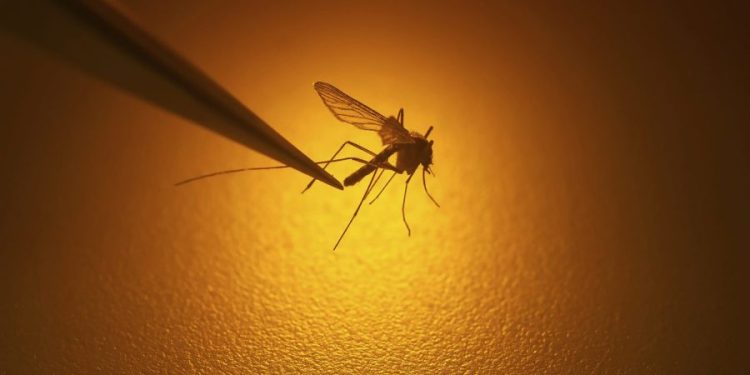California last week clocked its fourth case of locally transmitted dengue fever this year — an alarming rise in a sometimes-deadly disease that experts fear could be fueled by climate change.
The Los Angeles County Department of Public Health confirmed the newest incidence of the mosquito-borne illness in a resident of Panorama City, a neighborhood in Los Angeles’s San Fernando Valley. The department noted that the individual had not traveled to areas where dengue is endemic, and that the case appeared unrelated to three others, also locally acquired, that were reported in the county earlier this month.
“We are seeing the local transmission of dengue, which is unprecedented in Los Angeles County,” Muntu Davis, Los Angeles County health officer, said in a statement.
While stressing that such cases of local spread are extremely rare in the region, county officials urged residents to be proactive in preventing mosquito bites and breeding.
Spread by certain types of mosquitoes, dengue is a tropical and subtropical viral infection relayed to humans through bites, according to the World Health Organization (WHO). Although many infections have only mild, flu-like effects, the virus can also cause severe symptoms or even death.
The incidence of dengue has risen sharply in recent years, surging from 505,430 cases worldwide in 2000 to 6.5 million in 2023, WHO reported.
The global health agency attributed that increase to a shift in distribution of mosquitoes that carry the virus, weather phenomena and climate change. The latter, according to WHO, has brought higher temperatures, rainfall and humidity — conditions that are generally favorable to mosquitoes.
Florida has had locally acquired cases of dengue since at least 2010, according to data from the Centers for Disease Control and Prevention (CDC). Other states have also periodically presented with locally acquired cases in the past decade, including Texas, New York, West Virginia, North Carolina, Hawaii and Arizona.
But California, which had its first two locally spread dengue cases in 2023, is the only state besides Florida in which residents have caught the disease in the areas where they live this year.
Prior to the incident on Sept. 25, the Los Angeles County Department of Public Health announced two cases in the city of Baldwin Park on Sept. 18 and one in the same city on Sept. 9.
“This year and last have been two of the high-burden years of dengue on record around the world, and climate change is likely playing a large role in this,” Erin Mordecai, an associate professor in biology at Stanford University, told The Hill in an email.
“As dengue spreads more rapidly around the world, more cases get ‘imported’ into California,” she said, explaining that travelers are exposed elsewhere and then bring dengue into the state.
When there are “local vector populations” — of Aedes aegypti and Aedes albopictus mosquitoes — in California, imported cases can then cause “chains of local transmission,” Mordecai noted.
“This is still on a much smaller scale than dengue outbreaks in many endemic regions, but it is worth paying attention to because the more local transmission becomes established here, the more likely that it can spread,” she said.
Climate change is likely contributing to the global rise in dengue cases “by making the temperature more suitable for the vector [Aedes aegypti] and for transmission for longer stretches of the year,” according to Mordecai. Likewise, she explained, those conditions have made areas of California more compatible with dengue spread.
Extreme weather and floods can also cause infrastructural damage and help drive dengue outbreaks, as was the case in Peru in 2023, following Cyclone Yaku, Mordecai noted.
In recent years climate change has similarly contributed to an increase in the West Nile virus, which has seen broader transmission within the United States.
Because that virus can spread at much lower temperatures and is well established in wild birds and mosquitoes — whereas dengue mostly spreads between mosquitoes and humans only — there is a “reservoir” of West Nile-infected bugs ready to bite humans, Mordecai explained.
But while dengue has not yet come close to West Nile virus in terms of a domestic U.S. burden, Mordecai warned that “we could be headed in that direction.”
She described some opportunity to quell the spread of dengue, noting that there could be “be major benefits of reducing emissions and climate change for protecting against the worst increases in dengue in the future.”
She and her colleagues recently showed that historical climate change has already raised dengue incidence by 18 percent in the Americas and Asia, while projecting future surges of 40 to 57 percent by midcentury. But they also demonstrated how lower-emissions scenarios could “substantially reduce the warming-driven increase in dengue burden.”
Mordecai qualified that finding, however, with the disclaimer that “a lot of increases in dengue are already ‘baked in’ to the climate warming we have already set into motion.”
Nonetheless, she stressed the importance of reducing human-caused emissions, as doing so will be critical to curbing many negative impacts climate change has wrought on human health.
And in the short term, Mordecai urged Californians to “be vigilant and aware about avoiding mosquito bites and contacting their local vector control agency when they notice large numbers of mosquitoes.” She advised particular caution around mosquitoes that bite during the day, as dengue is typically spread by species that operate during those hours.
Davis, the Los Angeles County health officer, said in his public statement that “preventing mosquito bites and mosquito breeding is the best way stop the ongoing local transmission of dengue.”
He suggested that residents use insect repellent, eliminate items that hold standing water near their homes and install screen doors and windows.
Such proactive measures, Davis added, are some of the “simple steps everyone can take to significantly reduce the risk of mosquito-borne disease for both you and your neighbors.”














